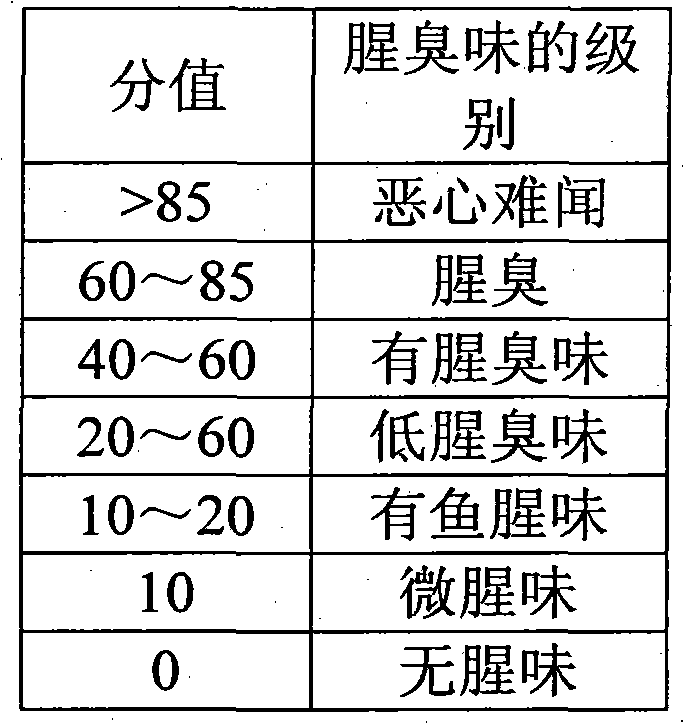Stink-free deep sea fish oil and preparation method and application thereof
A deep-sea fish oil and fishy smell technology, which is applied in application, fat oil/fat refining, edible oil/fat, etc., can solve the problems of high energy consumption, heavy pollution, and low yield in the production process, and achieve short heating time and deodorization effect Good, less disruptive effect
- Summary
- Abstract
- Description
- Claims
- Application Information
AI Technical Summary
Problems solved by technology
Method used
Image
Examples
Embodiment 1
[0028] (1) Pass the degummed and decolorized deep-sea fish oil (commercially available) through a wiped-film molecular distillation column with a vacuum of 0.01Pa and a temperature of 80°C. The retention time of the degummed and decolorized deep-sea fish oil in the wiped-film molecular distillation column is 5s , that is, deep-sea fish oil without fishy smell.
[0029] (2) Detection:
[0030] A. DHA and EPA content: use GC-MS to detect the DHA and EPA content in deep-sea fish oil, and the test results are as follows: Figure 1~2 As shown in Tables 1-2, it can be seen that the contents of DHA and EPA in the deep-sea fish oil after passing through the column are basically the same as those in the deep-sea fish oil before passing through the column.
[0031] Table 1 The chromatogram of deep-sea fish oil without fishy smell before passing through the column
[0032] Test substance
Peaking t(min)
Mass percentage (%)
EPA
33.608
19.027
DHA ...
Embodiment 2
[0042] (1) Pass the degummed and decolorized deep-sea fish oil (commercially available) through a wiped-film molecular distillation column with a vacuum degree of 10Pa and a temperature of 180°C. The retention time of the degummed and decolorized deep-sea fish oil in the wiped-film molecular distillation column is 10s. That is, deep-sea fish oil without fishy smell is obtained.
[0043] (2) Detection:
[0044] A. DHA and EPA content: use gas chromatography-mass chromatography to detect the DHA and EPA content in the deep-sea fish oil. Through the detection, we can know the DHA and EPA content in the deep-sea fish oil after passing the column and the DHA and EPA content in the deep-sea fish oil before passing the column. basically the same.
[0045] B, sensory evaluation: the deep-sea fish oil without fishy smell prepared by step (1) is evaluated according to the scoring table in Table 1, wherein two control groups are set, one is the degummed and decolorized deep-sea fish oil...
Embodiment 3
[0047] (1) The degummed and decolorized deep-sea fish oil (commercially available) is passed through a wiped-film molecular distillation column with a vacuum degree of 30Pa and a temperature of 200°C. The retention time of the degummed and decolorized deep-sea fish oil in the wiped-film molecular distillation column is 15s. That is, deep-sea fish oil without fishy smell can be obtained.
[0048] (2) Detection:
[0049] A. DHA and EPA content: Use GC-MS to detect the DHA and EPA content in the deep-sea fish oil. Through the detection, it can be known that the DHA and EPA content in the deep-sea fish oil after the column is higher than the DHA and EPA in the deep-sea fish oil before the column. The content decreases by mass percentage 0.24% and 0.15%.
[0050] B, sensory evaluation: the deep-sea fish oil without fishy smell prepared by step (1) is evaluated according to the scoring table in Table 3, wherein two control groups are set, one is the degummed and decolorized deep-se...
PUM
 Login to View More
Login to View More Abstract
Description
Claims
Application Information
 Login to View More
Login to View More - R&D
- Intellectual Property
- Life Sciences
- Materials
- Tech Scout
- Unparalleled Data Quality
- Higher Quality Content
- 60% Fewer Hallucinations
Browse by: Latest US Patents, China's latest patents, Technical Efficacy Thesaurus, Application Domain, Technology Topic, Popular Technical Reports.
© 2025 PatSnap. All rights reserved.Legal|Privacy policy|Modern Slavery Act Transparency Statement|Sitemap|About US| Contact US: help@patsnap.com



